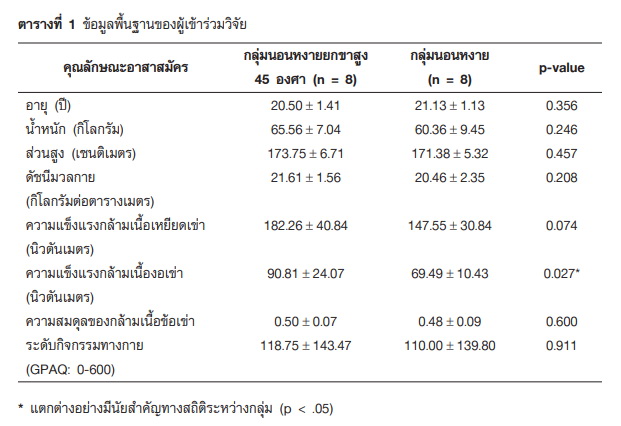COMPARISON OF EFFECTS BETWEEN SUPINE LYING WITH LEGS ELEVATED AND SUPINE LYING ON KNEE MUSCLE RECOVERY AFTER PLYOMETRIC EXERCISE IN LOW-ACTIVE HEALTHY MALE
Main Article Content
Abstract
Purpose The purpose of this study was to compare the effects of supine lying with and without legs elevation on knee muscle recovery after plyometric exercise.
Methods Sixteen low-active healthy males were randomly allocated to supine lying with legs elevated 45 degree (n=8) or a supine lying (n=8) position for 30 minutes per day that lasted 5 days after completed 100 drop jumps from a 0.6-m box to induce muscle soreness. Indirect indices of muscle soreness (Pain scale, Peak torque, Hamstring/Quadriceps ratio) were assessed before and 24, 48, 72, and 96 hours post-exercise.
Results Supine lying with legs elevated position showed statistical significant difference in peak torque of knee extensor by 96 hours compared with supine lying position. (p<0.05) However, there were no statistically significant differences in time between groups throughout the recovery period on pain scale and Hamstring/Quadriceps ratio variables.
Conclusions Supine lying with legs elevated tends to attenuate the sign of delayed-onset muscle soreness of knee extensor following plyometric exercise compared with supine lying position.
Article Details
References
Barak, O. F., Ovcin, Z. B., Jakovljevic, D. G., Lozanov-Crvenkovic, Z., Brodie, D. A., and Grujic, N. G. (2011). Heart rate recovery after submaximal exercise in four different recovery protocols in male athletes and non-athletes. Journal of Sports Science and Medicine, 10(2), 369-375.
Bogdanis, G. C. (2012). Effects of physical activity and inactivity on muscle fatigue. Frontiers in Physiology, 3, 142.
Chatzinikolaou, A., Fatouros, I. G., Gourgoulis, V., Avloniti, A., Jamurtas, A. Z., Nikolaidis, M. G., ... Taxildaris, K. (2010). Time course of changes in performance and inflammatory responses after acute plyometric
exercise. Journal of Strength and Conditioning Research, 24(5), 1389-1398.
Cheung, K., Hume, P., and Maxwell, L. (2003). Delayed onset muscle soreness : treatment strategies and performance factors. Sports Medicine, 33(2), 145-164.
Coghill, R. C., McHaffie, J. G., and Yen, Y. F. (2003). Neural correlates of interindividual differences in the subjective experience of pain. Proceedings of the National Academy of Sciences of the United States of America, 100(14), 8538-8542.
Connolly, D. A., Sayers, S. P., and McHugh, M. P. (2003). Treatment and prevention of delayed onset muscle soreness. Journal of Strength and Conditioning Research, 17(1), 197-208.
Ebbeling, C. B., and Clarkson, P. M. (1989). Exercise-induced muscle damage and adaptation. Sports Medicine, 7(4), 207-234.
Highton, J. M., Twist, C., and Eston, R. G. (2009). The Effects of exercise-induced muscle damage on agility and sprint running performance. Journal of Exercise Science and Fitness, 7(1), 24-30.
Jakeman, J. R., Byrne, C., and Eston, R. G. (2010). Lower limb compression garment improves recovery from exercise-induced muscle damage in young, active females. European Journal of Applied Physiology, 109(6), 1137-1144.
Kary, J. M. (2010). Diagnosis and management of quadriceps strains and contusions. Current Reviews in Musculoskeletal Medicine, 3(1-4), 26-31.
Larson, L. M., Smelter, R. M., Petrella, J. K., and Jung, A. P. (2013). The effect of active vs. supine recovery on heart rate, power output, and recovery time. International Journal of Exercise Science, 6(3), 180-187.
Liaw, M. Y., and Wong, M. K. (1989). [The effects of leg elevation to reduce leg edema resulting from prolonged standing]. Taiwan Yi Xue Hui Za Zhi. Journal of the Formosan Medical Association, 88(6), 630-634, 628.
Makaruk, H., and Sacewicz, T. (2011). The effect of drop height and body mass on drop jump intensity. Biology of Sport, 28(1), 63-67.
Marginson, V., Rowlands, A. V., Gleeson, N. P., and Eston, R. G. (2005). Comparison of the symptoms of exercise-induced muscle damage after an initial and repeated bout of plyometric exercise in men and boys. Journal of Applied Physiology (Bethesda, Md. : 1985), 99(3), 1174-1181.
Miyama, M., and Nosaka, K. (2004). Muscle damage and soreness following repeated bouts of consecutive drop jumps. Advances in Exercise and Sports Physiology, 10(3), 63-69.
Nuanjai, P., and Werasirirat, P. (2014). Comparison of effects between static stretching and petrissage massage on functional-sign of delayed onset muscle soreness of knee extensor following stimulated plyometric exercise in Thai male. Journal of Medical Technology and Physical Therapy, 26(2), 158-168.
Palanca, A. A., Yang, A., and Bishop, J. A. (2016). The effects of limb elevation on muscle oxygen saturation: a near-infrared spectroscopy study in humans. PM&R, 8(3), 221-224.
Peng, H.-T., Kernozek, T. W., and Song, C.-Y. (2011). Quadriceps and hamstring activation during drop jumps with changes in drop height. Physical Therapy in Sport, 12(3), 127-132.
Perrin, D. H. (1993). Isokinetic exercise and assessment. Champaign, IL: Human Kinetics
Publishers. Portes, E. M., Portes, L. A., Botelho, V. G., and Souza Pinto, S. (2007). Isokinetic torque peak and hamstrings/quadriceps ratios in endurance athletes with anterior cruciate ligament laxity. Clinics (Sao Paulo), 62(2), 127-132.
Rowlands, A. V., Eston, R. G., and Tilzey, C. (2001). Effect of stride length manipulation on symptoms of exercise-induced muscle damage and the repeated bout effect. Journal of Sports Sciences, 19(5), 333-340.
Safran, M. R., Seaber, A. V., and Garrett, W. E., Jr. (1989). Warm-up and muscular injury prevention. An update. Sports Medicine, 8(4), 239-249.
Stauber, W. T. (1989). Eccentric action of muscles: physiology, injury, and adaptation. Exercise and Sport Sciences Reviews, 17, 157-185.
Van den Bekerom, M. P. J., Struijs, P. A. A., Blankevoort, L., Welling, L., van Dijk, C. N., and Kerkhoffs, G. M. M. J. (2012). What is the evidence for rest, ice, compression, and elevation therapy in the treatment of ankle sprains in adults? Journal of Athletic Training, 47(4), 435-443.


